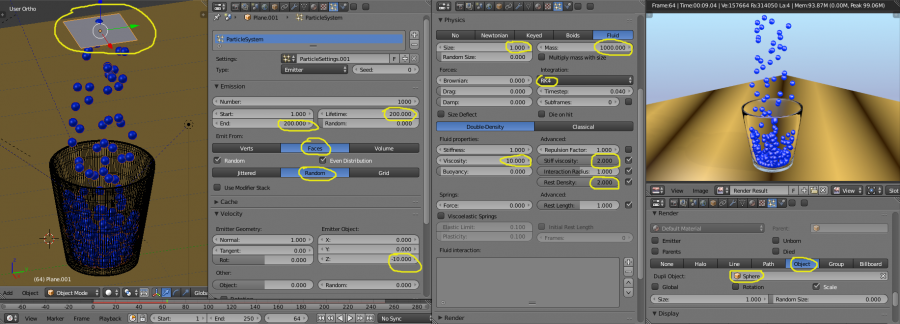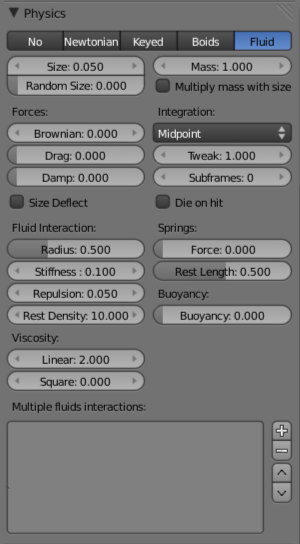Doc:2.6/Manual/Physics/Particles/Physics/Fluid
Fluid Physics
Fluid simulations are widely used in CG, and a very desired feature of any particle system, fluid particles are similar to newtonian ones but this time particles are influenced by internal forces like pressure, surface tension, viscosity, springs, etc. Blender particle fluids use the SPH techniques to solve the particles fluid equations.
Smoothed-particle hydrodynamics (SPH) is a computational method used for simulating fluid flows. It has been used in many fields of research, including astrophysics, ballistics, vulcanology, and oceanography. It is a mesh-free Lagrangian method (where the co-ordinates move with the fluid), and the resolution of the method can easily be adjusted with respect to variables such as the density.
From liquids to slime, goo to sand and wispy smoke the possibilities are endless.
Settings
Fluid physics share options with Newtonian Physics. These are covered on that page.
Fluid Properties
- Stiffness
- How incompressible the fluid is.
- Viscosity
- Linear viscosity. Use lower viscosity for thicker fluids.
- Buoyancy
- Artificial buoyancy force in negative gravity direction based on pressure differences inside the fluid.
Advanced
- Repulsion Factor
- How strongly the fluid tries to keep from clustering (factor of stiffness). Check box sets repulsion as a factor of stiffness.
- Stiff Viscosity
- Creates viscosity for expanding fluid. Check box sets this to be a factor of normal viscosity.
- Interaction Radius
- Fluid's interaction radius. Check box sets this to be a factor of 4*particle size.
- Rest Density
- Density of fluid when at rest. Check box sets this to be a factor of default density.
Springs
- Force
- Spring force
- Rest Length
- Rest length of springs. Factor of particle radius. Check box sets this to be a factor of 2*particle size.
- Viscoelastic Springs
- Use viscoelastic springs instead of Hooke's springs.
- Elastic Limit
- How much the spring has to be stretched/compressed in order to change its rest length
- Plasticity
- How much the spring rest length can change after the elastic limit is crossed.
- Initial Rest Length
- Use initial length as spring rest length instead of 2*particle size.
- Frames
- Create springs for this number of frames since particle's birth (0 is always).

